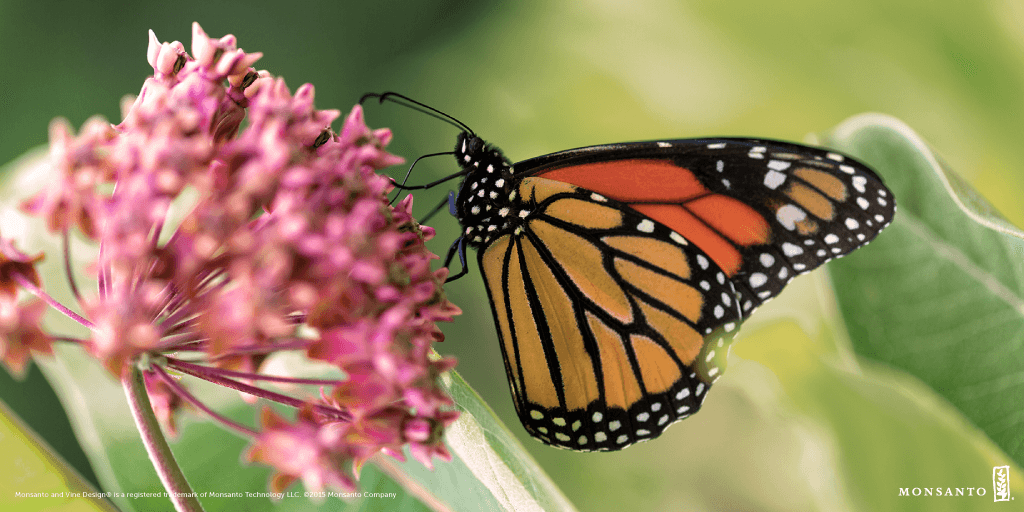News | May 11, 2017 | Read Time: 4 minutes
Epic Efforts Taking Wing for Monarch Butterflies


The flight of the monarch butterfly is one of nature’s greatest spectacles. For centuries, millions of monarchs have traveled as much as 3,000 miles across North America in the longest-distance insect migration on Earth.
I recently had the opportunity to visit the monarch’s winter home in Mexico and saw firsthand these victorious travelers’ focus on survival.
The monarch population that overwinters in Mexico varies annually but has declined over the past two decades. These beautiful and fragile butterflies are impacted by many factors, including continued illegal logging in Mexico, climate change, weather events, and the availability of nectar sources and milkweed habitat where they feed and lay their eggs.
Conservation groups have been working for years to increase milkweed habitat for monarchs. Federal agencies also have directed public funds to habitat restoration and to programs to improve biodiversity on public and private lands. But more efforts are needed. Monarch habitat must increase for the population to recover fully.
In 2013, leaders in agriculture, conservation groups, federal agencies and the research community came together to examine the challenges facing monarchs, share knowledge and perspectives, and ultimately to identify a path forward. They recognized that restoring monarch habitat and increasing farmers’ harvests can be compatible goals. Farmers and ranchers are traditional stewards of the land across much of the historical monarch habitat, putting them in a unique position to help support sustainable monarch butterfly populations. The parties began working together to promote practices to expand, enhance and protect milkweed habitat on range lands, conservation lands, and other non-crop areas adjacent to productive farms. This initiative became the Monarch Collaborative.
The Monarch Collaborative is a multi-stakeholder effort to help reestablish milkweed habitat along the monarch migration path and the U.S. Corn Belt, developing best management practices for creating and restoring habitat and providing education and outreach to farmers, ranchers and consumers alike. The Monarch Collaborative was seeded, in part, with a grant from Monsanto to the nonprofit Keystone Policy Center.
As a member of the Monarch Collaborative and other initiatives like the Iowa Monarch Conservation Consortium, Monsanto helps create greater awareness of the need for monarch habitat within agriculture, shares our knowledge and experience and provides funding as a catalyst for on-the-ground action. We also support the restoration of habitats for a range of pollinators and work to ensure that milkweeds are an important part of the mix.
As part of our commitment, we contributed $3.6 million to the National Fish and Wildlife Foundation (NFWF) over three years, as well as an additional $400,000 in grants to support several other partners.
Our support to NFWF resulted in 23 grants in 2015 to support habitat improvement and expansion. In fact, together these projects propose to restore more than 33,000 acres of habitat and create more than a half a billion milkweeds and other nectar plants to support monarchs.
Our commitment to the University of Kansas and Monarch Watch will provide 100,000 native milkweed plants for habitat expansion by the end of 2016. Already, 40,000 milkweeds have been planted to improve key habitat types across 18 states.
We’re also establishing and expanding milkweed habitats at 70 of our sites, including three learning centers that will support outreach and education to farmers and rural communities. And we’re connecting directly with farmers and ranchers to provide information resources, demonstration sites and calls to action in our Technical Use Guide document, which is made available to 360,000 farmers annually.
But our efforts to improve monarch butterfly habitat are not just limited to the agricultural sector. One of the groups we’re supporting – the Energy Resources Center at the University of Illinois at Chicago – is engaging the utility and transportation sectors to raise awareness and foster the exchange of information on best practices for habitat expansion, as well as drive habitat restoration activities.
Restoring habitat for monarch butterflies is an important part of Monsanto’s commitment to protect and promote biodiversity. I am honored to work with so many committed people and organizations dedicated to helping the monarch butterfly flourish for generations to come.









